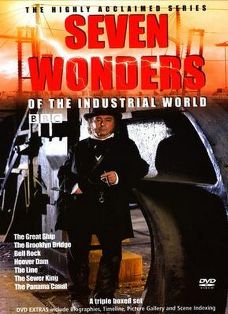Seven Wonders of the Industrial World facts for kids
Quick facts for kids Seven Wonders of the Industrial World |
|
|---|---|

BBC DVD cover
|
|
| Genre | Documentary Docudrama History |
| Written by |
|
| Directed by |
|
| Starring |
|
| Narrated by | Robert Lindsay |
| Composer(s) | Steve Jablonsky |
| Country of origin | United Kingdom |
| Original language(s) | English |
| No. of episodes | 7 |
| Production | |
| Producer(s) |
|
| Cinematography |
|
| Editor(s) |
|
| Running time | 50 minutes |
| Release | |
| Original release | 4 September – 16 October 2003 |
| Chronology | |
| Related shows | What the Industrial Revolution Did for Us |
Seven Wonders of the Industrial World is a 7-part British TV show. It's a docudrama, which means it mixes real facts with dramatic scenes. The series first aired on BBC from September 4 to October 16, 2003.
This show explores seven amazing engineering projects from the time of the Industrial Revolution. These projects changed the world. A book with the same name was also released by the show's producer, Deborah Cadbury.
Making the Show: How It Was Created
The show brought history to life by using actors. They played real people involved in these big projects. The actors' lines were based on actual letters and writings from these historical figures.
It cost about £1 million to make all seven parts of this documentary series. A book called Seven Wonders of the Industrial World was also written by producer Deborah Cadbury. It tells more about the same incredible engineering achievements.
Exploring the Seven Wonders
Each episode of the series focuses on a different amazing engineering feat. These projects show how human cleverness and hard work can change the world.
The Great Ship: Building a Giant of the Sea
This episode tells the story of the SS Great Eastern. This huge ship was designed by Isambard Kingdom Brunel. It was meant to be the first ship made entirely of iron. It was also planned to be the most luxurious ship of its time.
However, building the Great Eastern was very difficult. There were many accidents and money problems. These issues affected Brunel's health. He passed away in 1859, not long after the ship was finished. Some people even thought the ship was unlucky.
The Brooklyn Bridge: A Family's Legacy
This episode looks at the building of the famous Brooklyn Bridge in New York. It was a huge project led by one family. John Augustus Roebling designed the bridge. But he died shortly after the project began.
His son, Washington Roebling, took over the work. Washington later became very ill from decompression sickness. This happened because he spent so much time working in the underwater caissons. His wife, Emily Roebling, then learned engineering. She helped her husband finish the bridge.
Bell Rock Lighthouse: A Light in the Storm
This episode shares the story of the Bell Rock Lighthouse. It was built in the early 1800s off the coast of Scotland. The lighthouse stands on Bell Rock, a dangerous rock that was mostly underwater. Many ships had crashed there over hundreds of years.
The Scottish engineer Robert Stevenson designed this lighthouse. Building it was very hard. Workers could only build for a few hours a day at low tide. They also had to deal with strong storms and waves.
The Sewer King: Cleaning Up London
This episode takes us to London in the 1850s. The city's old sewer system was not good enough for its huge population. This caused diseases like cholera and a terrible smell called the Great Stink.
The episode follows Joseph Bazalgette, a brilliant engineer. He designed a new, modern sewer system for London. His work helped to clean the city and stop the spread of diseases. Interestingly, he didn't know exactly why his system worked so well at the time.
The Panama Canal: Connecting Two Oceans
This episode explores the efforts to build a canal through Panama. This canal would link the Atlantic Ocean and the Pacific Ocean. The first attempt was by the French, led by Ferdinand de Lesseps. He had built the Suez Canal.
However, this attempt failed. Many workers died from tropical diseases. Building a sea-level canal through the mountains was also very difficult. Seventeen years later, the United States took on the challenge. They fought the diseases and built the canal using locks.
The Line: Building a Transcontinental Railroad
This episode is about the First transcontinental railroad. This was the first rail system to connect the eastern and western parts of the United States. It was a massive undertaking.
One group started building from the west, through the tough Sierra Nevada mountains. They used many Chinese laborers. Another group built from the east. They faced challenges like the Wild West and attacks by Native Americans.
The Hoover Dam: A Monument in the Desert
The final episode focuses on the building of the Hoover Dam. This huge dam was constructed during the Great Depression in the 1930s. Frank Crowe was the builder. He pushed the workers very hard to finish the project quickly.
The workers faced very tough conditions. But they were desperate for jobs during the Depression. Many people died during the construction. A new city, Boulder City, was even built to house the workers.
Media Information
DVD Release Details
The series was released on DVD for different regions.
| DVD Region | Release Date | Publisher |
|---|---|---|
| Region 2 | 3 January 2005 | BBC Video |
| Region 4 | 6 February 2008 | BBC Video |
See also

